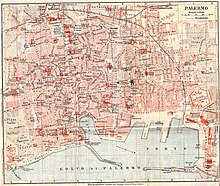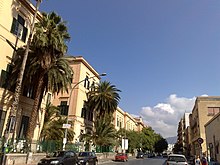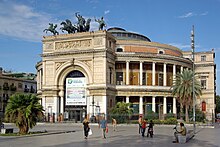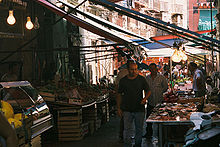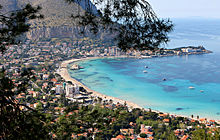Palermo
| Palermo | ||
|---|---|---|
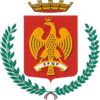
|
|
|
| Country | Italy | |
| region | Sicily | |
| Metropolitan city | Palermo (PA) | |
| Local name | Palermu / Paliemmu | |
| Coordinates | 38 ° 7 ' N , 13 ° 22' E | |
| surface | 158 km² | |
| Residents | 657,960 (Dec. 31, 2019) | |
| Population density | 4,164 inhabitants / km² | |
| Factions | Mondello , Sferracavallo | |
| Post Code | 90121-90151 | |
| prefix | 091 | |
| ISTAT number | 082053 | |
| Popular name | Palermitani | |
| Patron saint | Santa Rosalia | |
| Website | www.comune.palermo.it | |

|
||
Palermo ( Sicilian Paliemmu ) is the capital of the autonomous region of Sicily and the metropolitan city of Palermo . It is located on a bay on the north coast of Sicily . In the 8th century BC Founded in BC, the city flourished under the rule of the Arabs as well as the Normans and the Hohenstaufen . Palermo was u. a. Residence city of Friedrich II.
Today Palermo with 657,960 inhabitants (as of December 31, 2019) is Italy's fifth largest city and the political and cultural center of Sicily.
The current mayor is Leoluca Orlando , who was elected mayor for the fourth time on May 21, 2012.
geography
The city is located on a bay of the Tyrrhenian Sea on the north coast of Sicily. The bay is bounded in the north by Monte Pellegrino , which is around 600 meters high , and in the east by Monte Catalfano.
The plain between the mountains is called Conca d'Oro ("Golden Basin") in Italian , probably because of the orange groves that surrounded Palermo during the time of Arab rule. Today the urban area extends over almost the entire Conca d'oro . The plain is considered very fertile.
Palermo forms an agglomeration and is the largest city in Sicily with 659,433 inhabitants (2009) in the core city and just over a million inhabitants in the metropolitan area . Besides the inner-city Quartieri and Mandamenti following are frazioni in the outskirts of the city: Acqua dei Corsari, Altarello, Aquino, Arenella, Bandita, Boccadifalco, Brancaccio, Ciaculli, Mezzomonreale, Mondello , Pallavicino, Partanna, Pomara, Resuttana, San Lorenzo, Santuario di Santa Rosalia , Sferracavallo , Tommaso Natale, Vergine Maria, Villagrazia.
Palermo belongs to the "Regione Agraria n. 13 - Pianura Conca d'Oro" and is a member of the municipal associations "Associazione Italiana Città Ciclabili", "Associazione Nazionale Città del Pesce di Mare" and "Associazione Città italiane per la mobilità sostenibile e lo sviluppo dei trasporti ”.
Palermo is divided into eight districts ( circoscrizioni ), which in turn are divided into a total of 34 districts (quartieri).
The neighboring municipalities of Palermo are Altofonte , Belmonte Mezzagno , Ficarazzi , Isola delle Femmine , Misilmeri , Monreale , Torretta and Villabate .
climate
| Palermo | ||||||||||||||||||||||||||||||||||||||||||||||||
|---|---|---|---|---|---|---|---|---|---|---|---|---|---|---|---|---|---|---|---|---|---|---|---|---|---|---|---|---|---|---|---|---|---|---|---|---|---|---|---|---|---|---|---|---|---|---|---|---|
| Climate diagram | ||||||||||||||||||||||||||||||||||||||||||||||||
| ||||||||||||||||||||||||||||||||||||||||||||||||
|
Average monthly temperatures and rainfall for Palermo
Source:
|
|||||||||||||||||||||||||||||||||||||||||||||||||||||||||||||||||||||||||||||||||||||||||||||||||||||||||
history
Antiquity
The Phoenicians founded the city as a trading post in the 8th century BC. Chr. The original name of the city was possibly Ziz (flower) provided on a " sikulisch -punischen" coin stands and from the Punic comes. Ziz could therefore refer to the fertility of the landscape. The current name was given by the Greeks , who coveted the natural port of Palermo: Πάνορμος Panhormos = whole port, large port. 408, 406 and 391 BC The Carthaginians defended their model port against Syracuse and the fleets of other Greek cities and withdrew their strong bulwark of Hellenization .
In contrast to other large cities in Sicily, Palermo never came under Greek rule, but was close to the border with the Greek-speaking eastern part of the island.
275 BC In BC King Pyrrhos I of Epirus managed to occupy the port city for a short time.
During the First Punic War from 264 to 241 BC. Palermo was an important bulwark of the Carthaginians until it was built in 254 BC. It was conquered by the Romans through a sea blockade and was given the name Panormus . Former Roman legionaries settled under Augustus and Panormus developed into one of the most important cities in the province of Sicilia .
After the Vandals had founded their empire in North Africa in 429, with today's Tunisia as the center, they invaded Sicily several times and conquered the city. Palermo lost its importance and finally fell to Eastern Europe in 535 .
middle Ages

An upswing only started again under Islamic rule. Arabicبلرم / Called Balarm , Palermo became the capital of the emirs of Sicily in 831 and developed into a flourishing economic center through the cultivation of orange and citrus trees. The port was expanded and new districts were created. The population at that time is estimated at around 100,000 to 120,000. At that time, only Byzantium and Cordoba had more inhabitants among the European cities . In size it resembled the Islamic metropolises of the time, such as Cairo or Baghdad . According to Ibn al-Athīr , the Muslim emir Muhammad b. Abdallah b. Aghlab, who ruled Sicily from Palermo from 832 to 851, used the city as a starting point for incessant looting. Since ancient times, Sicily was the breadbasket of the world and the most desirable agricultural land of the Middle Ages. This made it a bone of contention among the political powers.
In 1072 the Normans under Roger I conquered Palermo. At the beginning of the 12th century it became the capital of the county, from 1130 of the Kingdom of Sicily. Under the Norman rulers numerous churches and palaces were built with distinctly Arab style influences. These buildings are evidence of an Arab-Byzantine-Norman symbiosis in art. Examples are the summer residence La Zisa in the style of an Arab desert castle or the churches of San Giovanni degli Eremiti and San Cataldo with their red-tinted domes. The Arabic style elements can also be seen on the Norman Palace and the Cathedral of Palermo , but the overall impression was lost due to later additions and modifications. Seven buildings in Palermo from this period have been a World Heritage Site since 2015 .
The cultural heyday under the Normans continued when the Hohenstaufen took power in 1194 . Frederick II expanded the city into a splendid residence and founded the Sicilian School of Poets .
After the execution of the last Hohenstaufen, Conradin , Sicily came under the rule of Charles of Anjou , who moved the capital of his empire to Naples. Palermo fell into disrepair and the poverty of the population led to the Sicilian Vespers in 1282 . With this uprising, Charles's rule in Sicily ended. Thousands of French were killed by the local population. 2000 people died in Palermo alone. The uprising led to the division of the Kingdom of Sicily into an insular and a continental Sicily. Palermo initially remained the capital of the island kingdom until it fell to the Crown of Aragon in 1412 and Palermo was only the seat of the viceroys of Sicily .
Modern times
In the period that followed, the Spaniards , Savoy and Austrians took possession of the city and it continued to lose importance. Even after Sicily and the Kingdom of Naples were ruled by the Bourbons in personal union, Palermo remained in the shadow of Naples . Only from 1806 to 1813, after the conquest of Naples by Napoleonic troops , King Ferdinand ruled Sicily from Palermo; in the Kingdom of the Two Sicilies , Naples became the capital again. In 1860 Giuseppe Garibaldi moved into Palermo and a year later Sicily became part of the new Kingdom of Italy .
During the Second World War , Palermo was badly damaged. Many residents of the old town moved to newly built settlements on the outskirts and the reconstruction work was only progressing very slowly. In 1946, Palermo became the capital of the newly established Autonomous Region of Sicily . The city experienced a strong influx of people from rural Sicily, so that the population grew rapidly. Around Palermo, cheap social housing estates were built en masse , while the restoration of the old center was neglected and it became increasingly dilapidated.
In addition, Palermo was firmly in the hands of the Mafia from the end of the war until the end of the 20th century . It was the center of two major mafia wars and was one of the most violent cities in Europe - during the second major mafia war between 1981 and 1983, one mafia murder occurred in Palermo on average every three days. In the 1980s, the prosecutors Giovanni Falcone and Paolo Borsellino in particular fought against it. In 1992 both were killed by the Mafia near Palermo. It was not until the “Antimafia” mayor Leoluca Orlando (term of office 1985–) that the city's public, economic and cultural life flourished again. Supported by other politicians, artists and the population, he continued the fight against the Mafia. Crime fell and today Palermo is no longer in the top 15 Italian cities in crime statistics, but is considered the safest city in Italy.
Orlando also initiated extensive renovation measures to restore the dilapidated buildings in the old town. So was z. For example, thanks to his efforts, the Teatro Massimo , one of the largest opera houses in Europe, reopened in 1997 and has since been continuously used with opera performances and concerts.
Population development
The inhabitants of the Sicilian capital are called Palermitans in German. Development of the population (in thousands)

economy
The most important economic sector of the 21st century is the service sector . Increasing tourism also contributes to this. Furthermore, Palermo is and was the location of various industrial companies from the chemical industry, vehicle and shipbuilding, mechanical engineering, glass and furniture production, metal and textile industry. The agriculture is dominated by food production, tobacco production and the grain industry. However, with the growing of citrus fruits and vegetables compared to the past, it plays a subordinate role. Despite the boom at the end of the 20th century, Palermo has the lowest per capita income of the metropolitan and provincial capitals in Italy and suffers from high youth unemployment. The port of Palermo is the most important in Sicily and is therefore also an economic factor that should not be underestimated.
science and education
Palermo is home to the University of Palermo, one of the largest universities in Italy. It was founded in 1806 and comprises twelve faculties. There is also a technical college as well as commercial, music and art schools, a theological faculty and a branch of the private university LUMSA. In 1832 the Accademia di Scienze, Lettere ed Arti emerged from the Accademia del Buon Gusto , founded in 1718 . The main task of the Istituto Siciliano di Studi Bizantini e Neoellenici , founded by Bruno Lavagnini , is to research the language, history and culture of Byzantine Sicily and southern Italy as well as modern Greek literature.
Libraries and Archives
The Central Library of the Region of Sicily ( Biblioteca Centrale della Regione Siciliana , formerly Biblioteca Nazionale ) acts as the general scientific library , which not only preserves printed matter but also a collection of medieval and modern manuscripts and the Tabulario (document archive) of the monastery and archbishopric of Monreale . The handwritten legacies of numerous Sicilian scholars, mainly theologians, philologists and historians, are among the treasures of the Biblioteca Comunale in the Casa Professa , the former Jesuit branch. There is no central university library; the supply of literature should be guaranteed by faculty and institute libraries. Another special library is the library of the Società Siciliana di Storia Patria near San Domenico .
The State Archives ( Archivio di Stato ) Palermo contains the archives of the Sicilian central administration, especially from the time of the viceroys, the archives of documents of abolished religious institutions and the files of the public notaries from the metropolitan city of Palermo since the 14th century as well as in the library the oldest Manuscript of the Getica des Jordanes . The archival sources on the history of the city are mainly to be found in the Archivio Comunale , the city archive in Via Maqueda. There is also an ethnographic archive in Via delle Pergole.
religion
Palermo has been the seat of a Roman Catholic diocese since the 1st century, which is today the metropolitan diocese of the ecclesiastical province of Palermo . The Eparchy Piana degli Albanesi of the Italo-Albanian Church is also represented in the city with the co- cathedral Santa Maria dell'Ammiraglio .
Due to the Arab rule, Palermo was influenced by Islam in the Middle Ages , before this influence was pushed back from the 13th century. Also because of the increased influx of North African immigrants, a mosque was inaugurated in the city center in 1990.
traffic
Most of the passenger and freight traffic takes place on the road. Palermo has a connection to the A19 motorway to Catania and via it to the A20 to Messina and the A29 to Mazara del Vallo and Trapani .
The Palermo Centrale railway station is the terminus of the railway axis from Berlin . The most important connection in Sicily is the railway line to Messina . Other connections lead to Agrigento , Catania and Trapani .
An urban railway system, the Servizio ferroviario metropolitano di Palermo , around the city ensures local transport.
On December 30, 2015, the Palermo tram started operating with 4 lines after construction work began in 2007. The lines go as follows: SL 1 (5.5 km): Stazione Centrale to Roccella (15 stations) SL 2 (5 km): Stazione Notarbartolo via Giotto / Migliaccio and Michelangelo / Castellana to Borgo Nuovo, Piazza Armerina / S. Paolo (13 stations) SL 3 (5 km): Stazione Notarbartolo via Giotto / Migliaccio and Michelangelo / Castellana to CEP (12 stations) SL 4 (4.1 km): Stazione Notarbartolo via Giotto / Migliaccio to Pollaci / Calatafimi (18 stations ) The vehicle fleet consists of 17 Bombardier Flexity Outlooks (5 parts, 32 m long and 2.4 m wide).
About 30 km northwest of the city is the international airport Palermo-Punta Raisi “Falcone e Borsellino” . The old Palermo-Boccadifalco Airport is about 5 km west of the city center .
Car ferries and the like run from the port. a. to Genoa , Civitavecchia and Naples . There are also boat connections to Tunis , Cagliari , Ustica , Malta and seasonally along the north coast of Sicily to Cefalù and the Aeolian Islands .
Cityscape and buildings
Places
The central square of the old town is Quattro Canti at the intersection of the main streets Corso Vittorio Emanuele and Via Maqueda. The baroque palaces at the four corners have concave curved facades of almost the same structure. They are adorned with fountains and statues depicting the four seasons, the Spanish kings of Palermo and the patron saints of the old quarters.
The Piazza Pretoria was laid out near the Quattro Canti in the 16th century to make way for a large mannerist fountain, the Fontana Pretoria .
The Piazza della Rivoluzione recalls that the uprising against the Bourbons began here in 1848 and that twelve years later Giuseppe Garibaldi appeared for the first time in Palermo. The Fontana del Genio fountain in the center of the square is one of the city's landmarks.
The Piazza Ruggero Settimo is in front of the Teatro Politeama and is one of the focal points of urban life. The square is named after the president of the short-lived Republic of Sicily in 1848. Other main attractions are the Piazza Bellini in front of the La Martorana church, the Piazza Verdi in front of the Teatro Massimo and the Piazza Indipendenza south of the Norman Palace .
The Piazza Marina is located on the edge of the historic district of La Kalsa . It was designed in 1863 by the architect Giovanni Battista Basile . The Giardino Garibaldi is located on it . The piazza is surrounded by 15 palaces, including the Palazzo Chiaramonte , the Palazzo Notarbartolo and the Palazzo Mirto .
Churches
The most important church building in Palermo is the cathedral . The current building was built in 1184/1185 and has undergone several alterations over the centuries. The renovation at the end of the 18th century, when the cathedral was given a baroque dome and its interior was redesigned in a classical style, was particularly serious. The cathedral is of particular importance for Germany because it contains the graves of the Hohenstaufen Henry VI. and Frederick II and his mother Constance of Sicily . The crypt and the cathedral treasure are also worth seeing.
There are several churches in the Arab-Norman style in Palermo . Unusual for church buildings are their domes , colored red on the outside , reminiscent of Islamic art . The oldest of these church buildings, San Giovanni dei Lebbrosi , was built by Roger I in 1071 , before the conquest of Palermo outside the walls of that time. San Giovanni degli Eremiti was built by Roger II shortly after his appointment as King of Sicily in 1130 as part of the first Roman Catholic monastery in Sicily. In addition to the church, which is now empty, the cloister is also well preserved. La Martorana (Santa Maria dell'Ammiraglio), built from 1143, is co-cathedral of the Italo-Greek Church in Sicily. San Cataldo , built next to the Martorana from 1154 to 1160, and La Magione (SS Trinità) are among the last churches in Sicily to be built in the Arab-Norman style.
The Romanesque Chiesa di San Giovanni alla Guilla was redesigned in Baroque style.
Among the Gothic churches include Santo Spirito , built in the 12th century, Sant'Agostino and San Francesco d'Assisi , both built in the 13th century. The church building Santa Maria dello Spasimo , built from 1506, now houses a cultural center where theater and music events take place. Santa Maria della Catena , built between 1500 and 1540, is an example of the late Gothic Catalan architectural style .
The oldest Sicilian Jesuit church, Chiesa del Gesù , was built from 1564. The city library is now located in the Jesuit house belonging to the church. Other church buildings from the 16th century that are worth seeing are the church of Santa Caterina with a facade in the style of the late Renaissance , the Oratorio di San Mercurio as well as the Oratorio di San Lorenzo and the Oratorio del Rosario with valuable stucco decorations. The church of San Giuseppe dei Teatini , built between 1612 and 1645, has a magnificent baroque palace facade. The baroque Cappella Maria SS. Della Soledad is located in the Piazza della Vittoria. In 1605 the church of Santi Quaranta Martiri Pisani was built . The Chiesa di San Gregorio Papa , destroyed in 1683, was rebuilt in 1740. The Chiesa di San Ciro was built in 1730 and the Chiesa dei Santi Pietro e Paolo in the 19th century .
The neo-Gothic Chiesa Anglicana della Holy Cross at the intersection of Via Roma and Via Mariano Stabile is an Anglican church.
From 1599, under a Capuchin monastery, the Capuchin Crypt was built , an extensive grave complex in which approx. 1200 mummies are kept dressed according to their status.
The baroque church of Santi Diecimila Martiri is now profaned.
Palaces
The Norman Palace (Palazzo dei Normanni or Palazzo Reale) used to be the seat of the kings and viceroys of Sicily and is now the seat of the Sicilian Parliament . Particularly worth seeing are the Cappella Palatina and Roger's room, both with mosaics from the Norman era. The Porta Nuova is attached to the Norman Palace on the site of an earlier city gate. Other castles from Norman times that were built by Arab master builders are La Zisa and La Cuba .
The aristocratic palaces from the Middle Ages usually have a fortress-like ground floor without windows. Only on the upper floor are there larger windows that are mostly divided by arcades and the edges of which are decorated with ornaments. The 14th century Palazzo Chiaramonte is a prime example . In the centuries that followed, it served as the residence of the viceroys, the seat of the Inquisition and a court. The Palazzo Sclafani was built in 1330 in the Gothic style with Arabic and Norman elements and was converted into a hospital in 1435. The Palazzo Abatellis is a square block with a richly decorated portal. It served as a Dominican monastery for a long time. Today the regional gallery is located there. The Palazzo Branciforte was one of the largest and most magnificent aristocratic residences in the city in the 17th century. Later a pawn shop was housed in the building. Since 2012 it has been the seat of the Fondazione Sicilia Foundation (formerly the Banco di Sicilia Foundation), which shows its collection in the former noble palace.
The Palazzo Pretorio (or Palazzo Senatorio) in Piazza Pretoria is Palermo's town hall. The building originally dates from the 15th century, but has been structurally changed and enlarged several times. It received its current form in the 19th century. The Palazzo Aiutamicristo near the church La Magione was built in 1490 by order of a merchant family from Pisa. The Archbishop's Palace with the Diocesan Museum is located near the cathedral .
On the edge of the Parco della Favorita city park is the Palazzina Cinese , built for Ferdinand III. of Sicily in 1799.
Museums and galleries
The Regional Archaeological Museum (Museo Archeologico Regionale "Antonio Salinas") shows a collection of unique exhibits from the prehistory of Sicily to the late Roman period.
The Regional Gallery (Galleria Regionale della Sicilia) in the Palazzo Abatellis is Sicily's most extensive gallery. The collection includes paintings and sculptures from the Middle Ages to the 18th century. One of the most famous exhibits is the "Annunziata" by Antonello da Messina .
The Diocesan Museum (Museo Diocesano) in the Archbishop's Palace shows religious art and sacred objects from the 12th to the 19th century. In the basement there are excavation exhibits and depictions of urban development.
The Ethnographic Museum (Museo Etnografico) documents Sicilian folk art and traditions with over 4000 exhibits. To be exhibited u. a. Sicilian carts and handmade Sicilian puppet theater puppets . The Museo Internazionale delle marionette Antonio Pasqualino also shows around 3000 marionettes from all over Sicily.
The Modern Art Gallery (Galleria d'Arte Moderna) reopened in December 2006. The art gallery, the holdings of which were temporarily stored in the Teatro Politeama for almost 100 years , is now located in the monastery buildings of the former Franciscan convent of Sant'Anna and shows contemporary sculptures, pictures and installations on 4700 m².
The geological-paleontological museum (Museo Geologico Gemmellaro) presents in four halls exhibits on the field of mineralogy , especially Sicilian rocks, information on geological history and fossils , especially on mammals that have died out on the island with a collection of Sicilian dwarf elephants and documentation on the culture of the first Sicilians.
theatre
The neoclassical Teatro Massimo was built at the end of the 19th century. The artfully designed theater room offers space for around 1300 guests.
When the Teatro Massimo was closed for two decades due to structural defects and extensive renovation work at the end of the 20th century, the Teatro Politeama served as a replacement stage. Today concerts and ballet performances take place here.
Parks
The Norman kings of the High Middle Ages laid out gardens in Palermo. Only small traces of this have survived today.
Palermo's largest park is the Parco della Favorita at the foot of Monte Pellegrino, which was built in 1798 by King Ferdinand III. was created. Today the park is a public park with tennis and soccer fields and a horse racing track.
At the end of the 18th century, the botanical garden was also laid out, in which Goethe looked for the " original plant ". Today it is home to over 12,000 species of plants. Next to the Botanical Garden, which is part of the University's Botanical Institute, is the Villa Giulia , a geometrically designed park with a fountain and sundial.
The largest fig trees in Europe grow in the Giardino Garibaldi , a small park in front of the Palazzo Chiaramonte . From the Norman Palace in the direction of the University of the Parco d'Orleans , in the direction of the cathedral at the Piazza Vittoria, the palm-tree park Villa Bonanno with the remains of Roman houses.
graveyards
The Sant'Orsola cemetery is located at the polyclinic in the Vespri district. It has an old and a new part. Here is the funerary chapel of the Falcone family, in which the judge and mafia opponent Giovanni Falcone was buried. The Chiesa dei Vespri ( Santo Spirito ), in front of which the Sicilian Vespers began in 1282, is located on the cemetery grounds .
The judge and mafia opponent Paolo Borsellino and the embalming specialist Alfredo Salafia rest in the cemetery of Santa Maria di Gesù .
The Santa Maria dei Rotoli cemetery is located northwest of the port area at the foot of Monte Pellegrino . It was created in a round, symmetrical shape. Here is the grave of the sculptor Ernesto Basile . There is a foreigner cemetery attached where the grave of the Whitaker family can be found.
Nobles and citizens in particular were buried in the catacombs of the Capuchin Order . B. Tomasi di Lampedusa . The underground graves are mostly arranged according to occupations and nobility. You can see the remains of the dead in their work or holiday clothes.
additional
The Giudecca is the Jewish district in Palermo, which can be reached from Corso Vittorio Emmanuele via Porta di Ferro or Porta Judaica.
Palermo has some large markets that stretch across the streets and alleys of the old town. The most famous and largest food market is the Mercato della Vucciria (La Vucciria for short). It was originally the butchers 'market, later the fishermen's stalls followed, then the farmers' stalls.
The Mercato Ballarò is mainly a fruit and vegetable market, while clothing is sold at the Mercato del Capo in addition to fresh food. There is also the Il Borgo night market, which is more of a street festival than a market and is famous for its liveliness.
The Ponte dell'Ammiraglio is a medieval bridge that originally spanned the Oreto, but is now about 100 m away from the river.
Surroundings
About 8 km southwest of the city center is the Cathedral of Monreale . Its walls depicted the stories of the Old and New Testaments with over 6000 m² of gold mosaics . The square cloister with over 200 double columns is also worth seeing .
To the north of the city center are the Monte Pellegrino with the sanctuary of St. Rosalia and stone age rock carvings as well as the former fishing village of Mondello , which developed into the summer resort of wealthy Palermitans at the beginning of the 20th century.
To the east of the city are the baroque villas of Bagheria and the archaeological sites of Solunt , an originally Phoenician settlement in the foothills of Palermo.
people
Well-known Palermitans are u. a. the Holy Rosalia , the patron saint of Palermo, the alchemist Alessandro Cagliostro , the writer Giuseppe Tomasi di Lampedusa , the sculptor Ettore Ximenes , the Mafia opponent and victim Giovanni Falcone and Paolo Borsellino and the longtime mayor of Palermo, Leoluca Orlando .
Town twinning
There are 28 places named Palermo in the world. One of them is the city of Palermo in Colombia : in 1906 the city of Guagua changed its name to Palermo, because many Palermitans had emigrated there and Saint Rosalia is also venerated there. Since 1998, the two Palermo combines a city partnership .
Palermo lists a total of eleven twin cities :
| city | country | since |
|---|---|---|
| Bethlehem |
|
|
| Bizerte |
|
2000 |
| Bukavu |
|
1998 |
|
Cheng you |
|
1999 |
|
Danzig |
|
2005 |
|
Dusseldorf |
|
2016 |
|
Hanoi |
|
2000 |
|
Yaroslavl |
|
1998 |
| Chan Yunis |
|
1998 |
|
Miami |
|
1997 |
| Palermo |
|
1998 |
|
Santiago de Cuba |
|
1996 |
|
Sestu |
|
1999 |
|
Tbilisi |
|
1997 |
Festivals

In honor of St. Rosalia , the patron saint of the city, there is a big festival every year from July 13th to 15th ("U Fistinu - Festino di Santa Rosalia"). The custom goes back to 1624, when, as if by a miracle, Rosalia's plague epidemic ended. The highlights of the festival are a solemn procession with the silver shrine of the saint through the city and a large fireworks display at the La Cala harbor.
On the night of September 3rd to 4th, a torchlight procession goes to Monte Pellegrino, the pilgrimage site of St. Rosalia.
Sports
Palermo's most successful football club is FC Palermo (formerly US Palermo ). The club's home games take place in the Stadio Renzo Barbera stadium, which can seat 37,000 people. The FC was among a total of 29 years of Serie A at the highest Italian league, and played for a demotion to the season 2019/20 in the fourth division Serie D , but went straight into the Series C on. The team's nickname is "Rosanero" after the club colors pink and black.
Every year in May an international horse show takes place in the Parco della Favorita .
The Giro d'Italia 2008 started in Palermo with a team time trial.
literature
- Brigit Carnabuci: Sicily. Greek temples, Roman villas, Norman cathedrals and baroque cities in the center of the Mediterranean (= DuMont art travel guide ). 6th, updated edition. DuMont Reiseverlag, Ostfildern 2011, ISBN 978-3-7701-4385-6 .
- Eva Gründel, Heinz Tomek: Sicily . DuMont Buchverlag, Cologne, 5th edition 2001, ISBN 3-7701-3476-1 .
Web links
|
Further content in the sister projects of Wikipedia:
|
||
|
|
Commons | - multimedia content |
|
|
Wiktionary | - Dictionary entries |
|
|
Wikinews | - News |
|
|
Wikivoyage | - Travel Guide |
- Website of the city of Palermo (Italian)
- Entry on the UNESCO World Heritage Center website ( English and French ).
- Tourist Office (also in German)
- Country and people in historical pictures and texts. With Goethe's diary
- Palermo, the architectural monuments in historical pictures and texts
Individual evidence
- ↑ Statistiche demografiche ISTAT. Monthly population statistics of the Istituto Nazionale di Statistica , as of December 31 of 2019.
- ^ World Weather Information Service. Retrieved July 16, 2019 .
- ↑ Not so, however, Sabatino Moscati : The Phoenicians. IB Tauris, New York - London 2001 (first edition: Milan 1988) p. 242: “... its [Panormus] Punic name is unknown to us. It is very unlikely that it can be assigned the Phoenician name Ziz, which is found on a coin. " ; carefully N. Keith Rutter: Magna Grecia e sicilia. In: Francesco Panvini Rosati (ed.): La moneta greca e romana. L'Erma di Bretschneider Rome, 2000, p. 58: "... Ziz (probilamente Panormus)" .
- ↑ Article on the inauguration of the mosque in La Repubblica from November 7, 1990
- ↑ Hans-Rudolf Meier : "... the earthly paradise that opens to view". The garden palaces of the Norman kings in Palermo . In: Die Gartenkunst 6 (1/1994), pp. 1–18.
- ↑ Palermo Porta del Mediterraneo - Europe - Africa - Medioriente. Retrieved November 9, 2019 .
- ^ State capital Düsseldorf: City partnerships - State capital Düsseldorf. In: www.duesseldorf.de. Retrieved November 18, 2016 .





